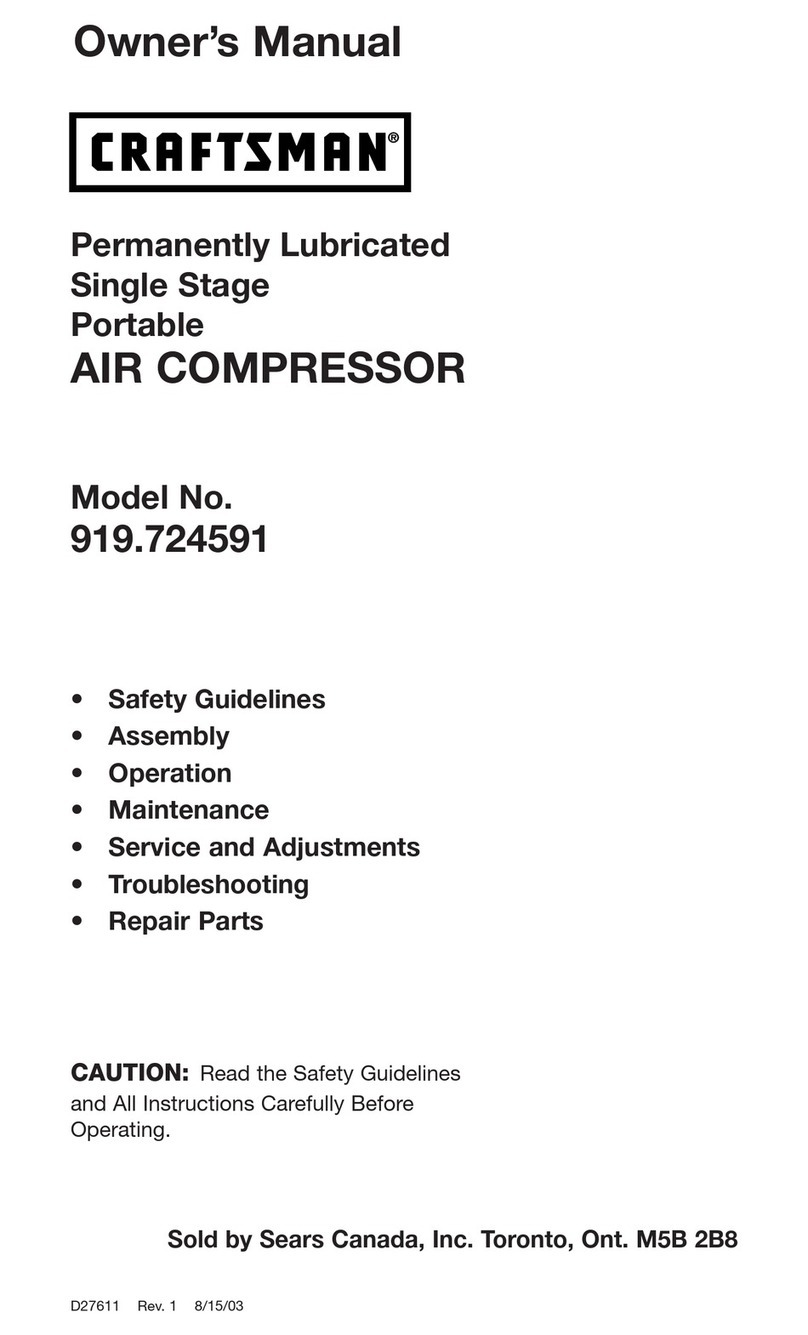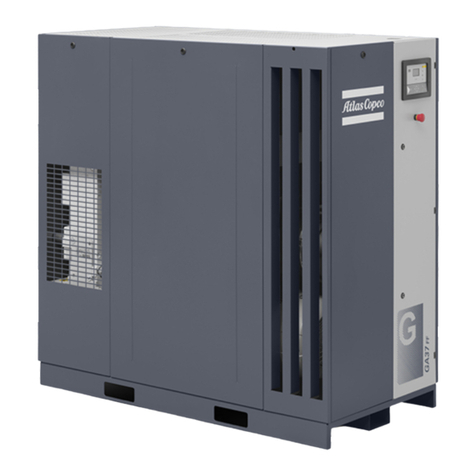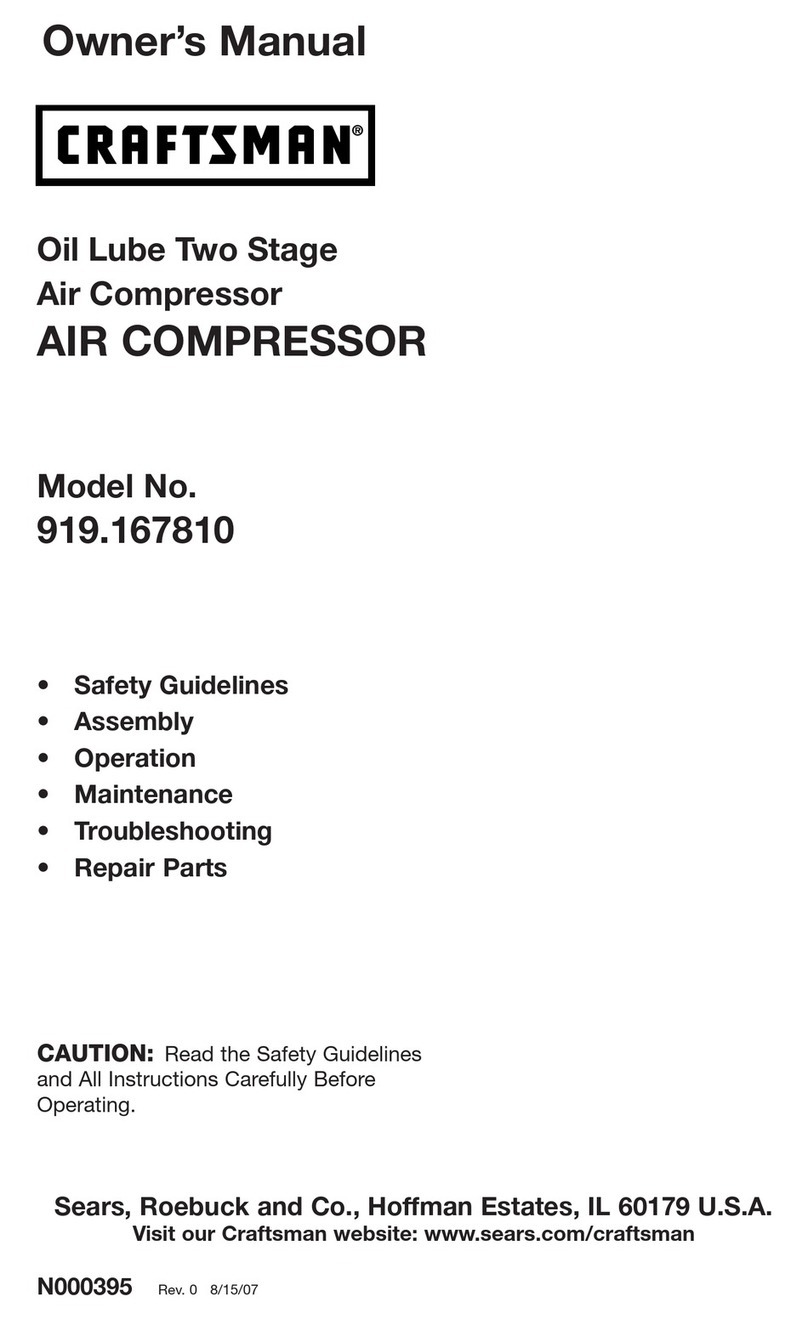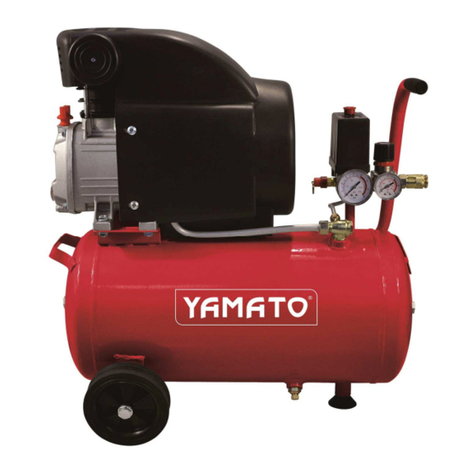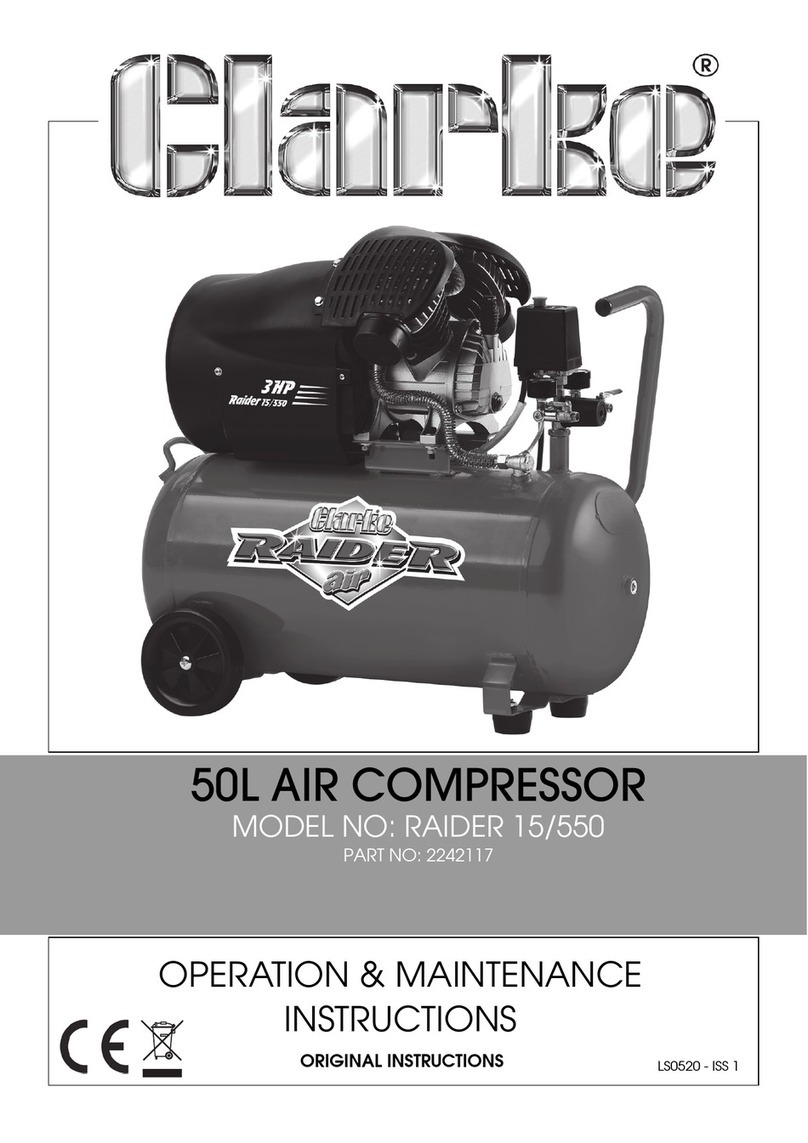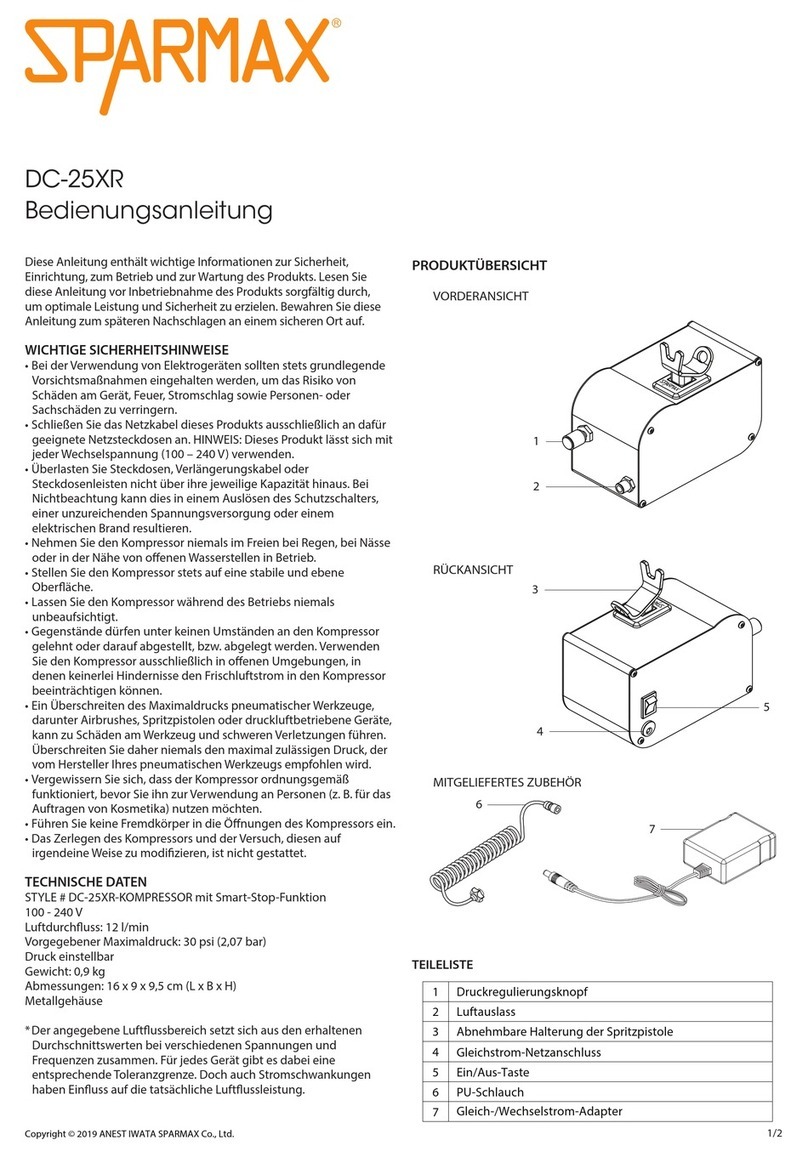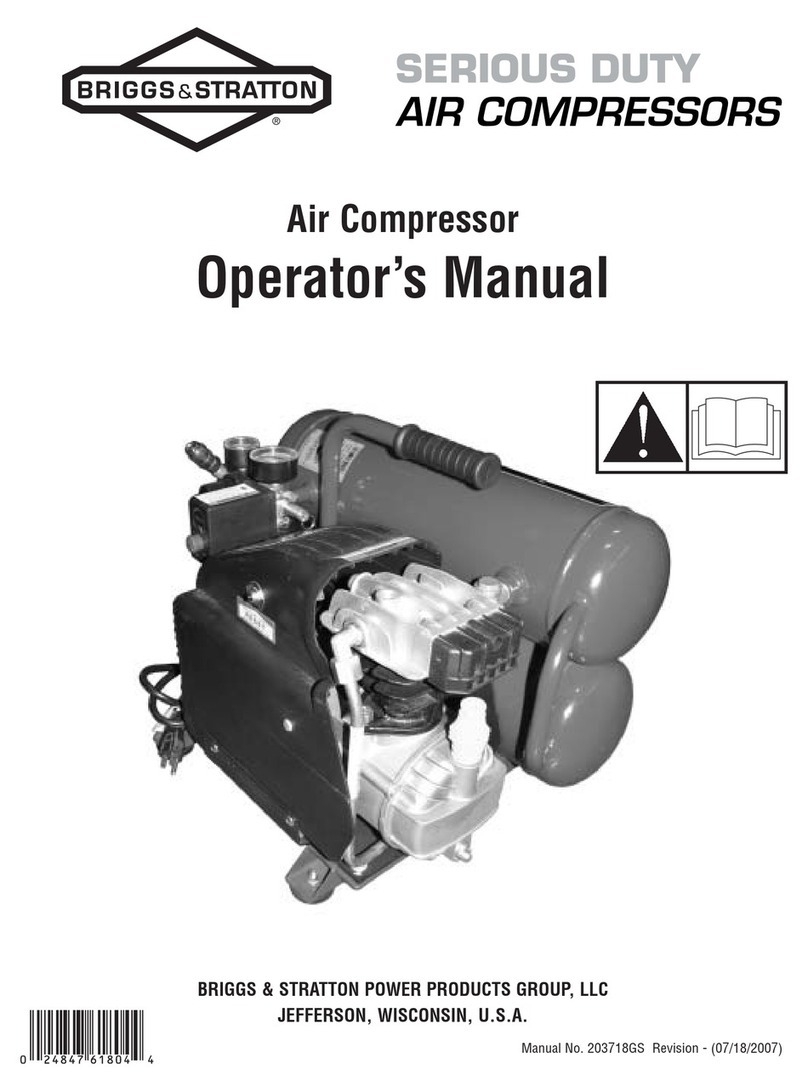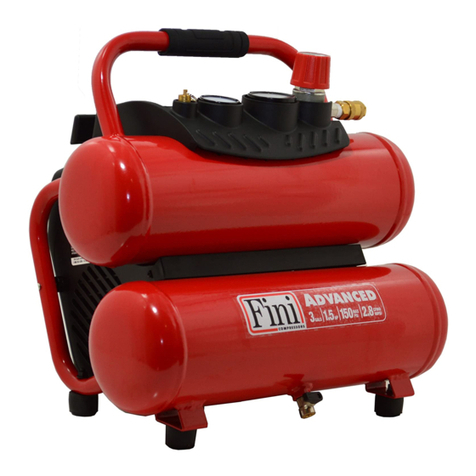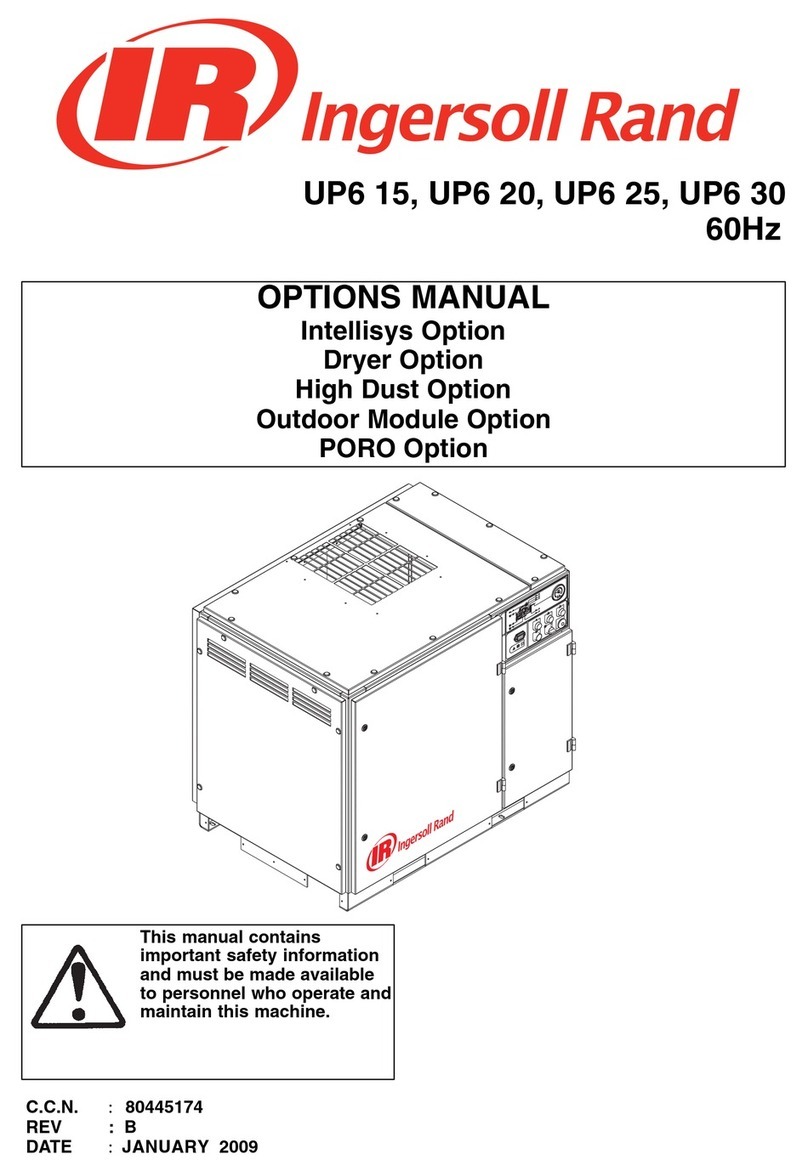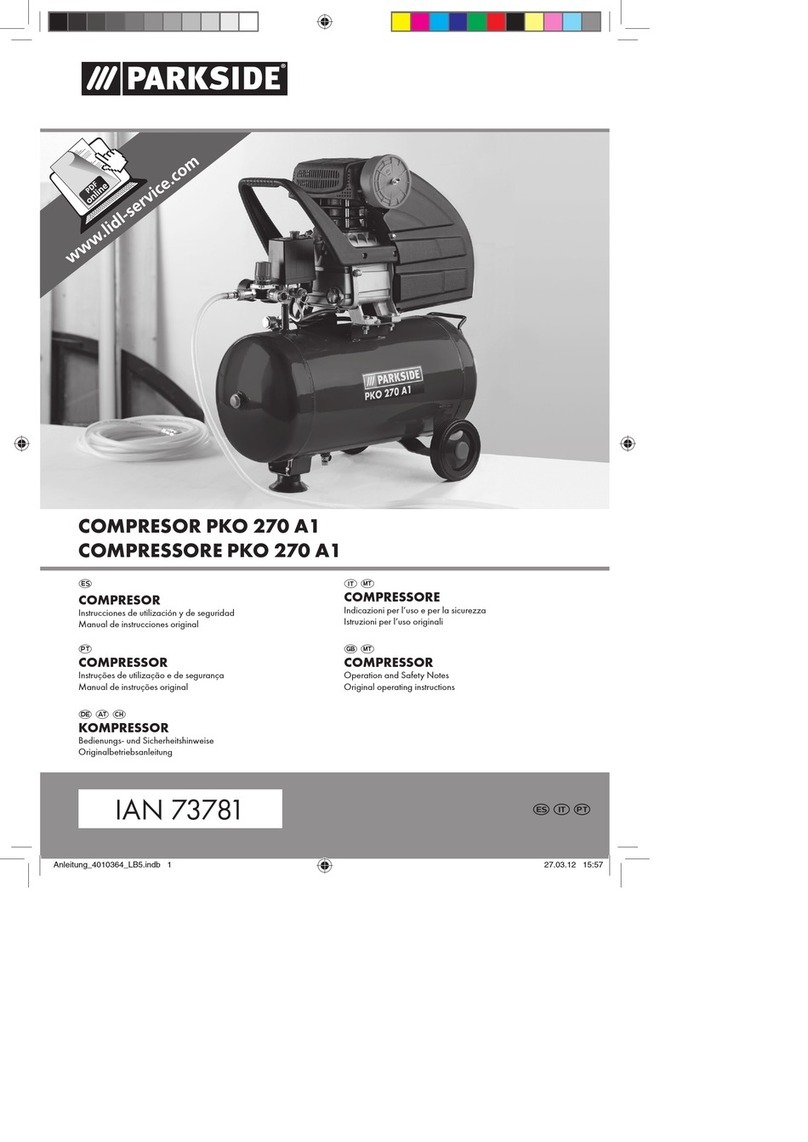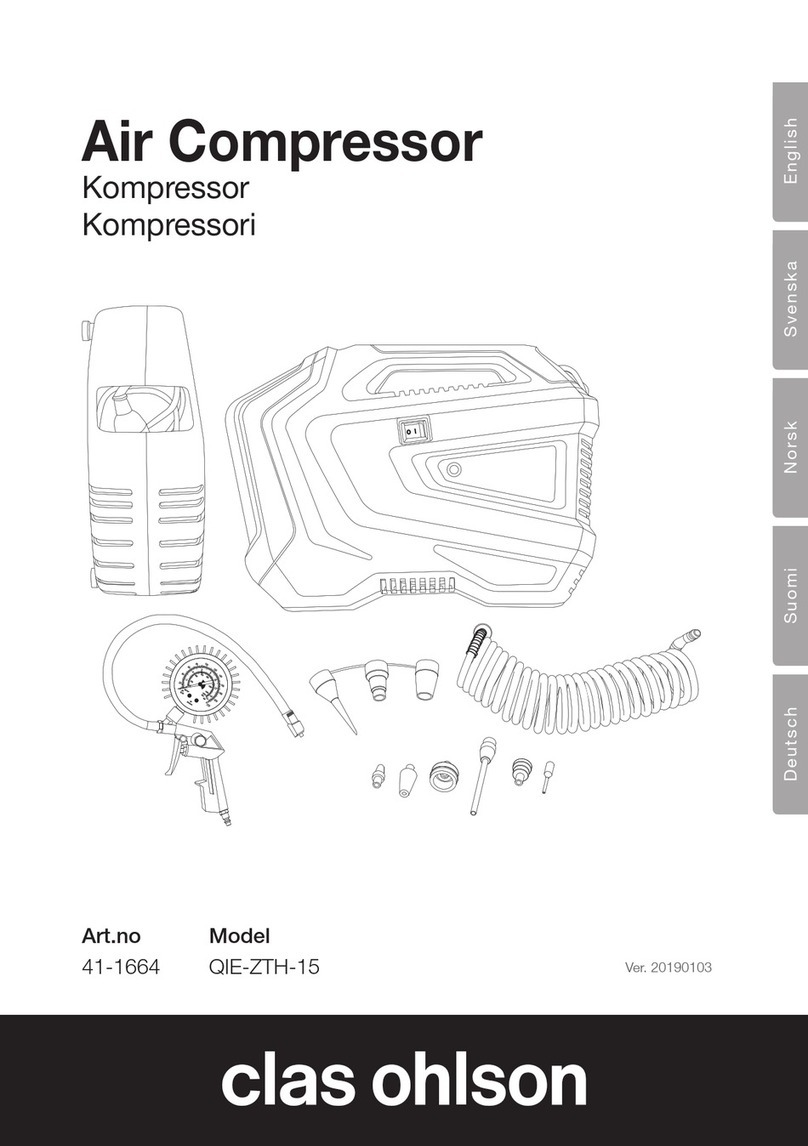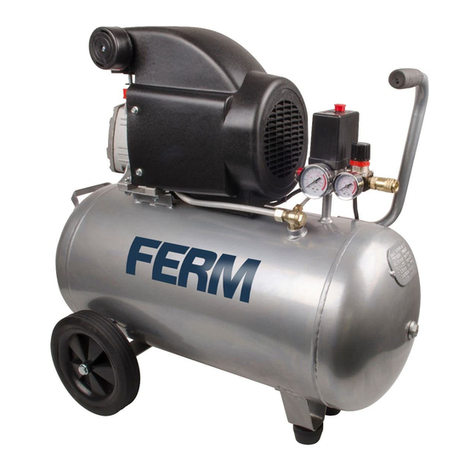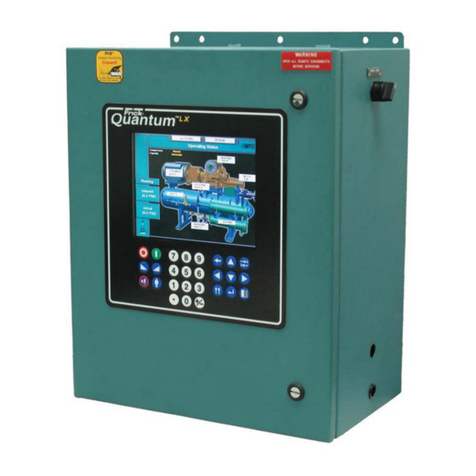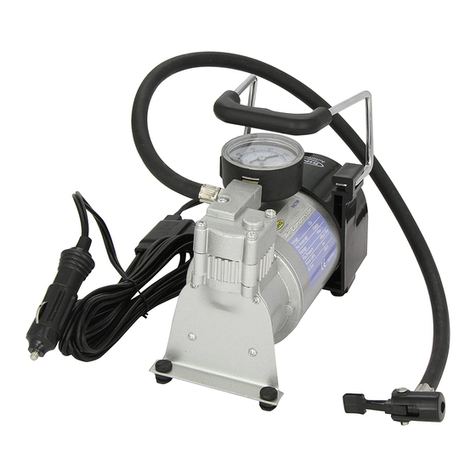Pro Force VPF1080318 User manual

200-2705
E103525
Revision A
Operator-Parts Manual
Oilless, Single Stage, Direct Drive, Electric Air Compressors
200-2705 (E103525)_ Rev A_7-08
WARNING: Read and understand all safety precautions in this manual before operating. Failure to comply with
instructions in this manual could result in personal injury, property damage, and/or voiding of your warranty. The
manufacturer WILL NOT be liable for any damage because of failure to follow these instructions.
Specification Chart
Questions? See back page.
?
Product style and configuration may
vary.
MODEL NO. RUNNING
H.P.
(CV)
TANK CAPACITY
GALLONS
VOLTAGE/AMPS/
PHASE
KICK-IN
PRESSURE
KICK-OUT
PRESSURE
VPF1080318 1.0 3 (11,4) 120/12/1 95
(6,55 bar)
125
(8,62 bar)

200-27052
SAFETY GUIDELINES . . . . . . . . . . . . . . . . . . . . . . . . . . .3
OVERVIEW . . . . . . . . . . . . . . . . . . . . . . . . . . . . . . . . . . .6
Basic Air Compressor Components . . . . . . . . . . . . .6
ASSEMBLY . . . . . . . . . . . . . . . . . . . . . . . . . . . . . . . . . . .7
Assembling the Compressor . . . . . . . . . . . . . . . . . . .7
COMPRESSOR CONTROLS . . . . . . . . . . . . . . . . . . . . . .8
ELECTRICAL POWER REQUIREMENTS . . . . . . . . . . . .9
Electrical Wiring . . . . . . . . . . . . . . . . . . . . . . . . . . . . .9
Extension Cords . . . . . . . . . . . . . . . . . . . . . . . . . . . .9
Grounding Instructions . . . . . . . . . . . . . . . . . . . . . . .9
OPERATING INSTRUCTIONS . . . . . . . . . . . . . . . . . . . .11
Daily Startup . . . . . . . . . . . . . . . . . . . . . . . . . . . . . .11
Shutdown . . . . . . . . . . . . . . . . . . . . . . . . . . . . . . . . .11
MAINTENANCE . . . . . . . . . . . . . . . . . . . . . . . . . . .13 & 16
Draining the Tank . . . . . . . . . . . . . . . . . . . . . . . . . .13
Checking the Relief Valve . . . . . . . . . . . . . . . . . . . .16
Testing for Leaks . . . . . . . . . . . . . . . . . . . . . . . . . . .16
Storage . . . . . . . . . . . . . . . . . . . . . . . . . . . . . . . . . .16
Service interval . . . . . . . . . . . . . . . . . . . . . . . . . . . .16
PARTS LIST . . . . . . . . . . . . . . . . . . . . . . . . . . . . . . .14-15
TROUBLESHOOTING CHART . . . . . . . . . . . . . . . . . . .17
TABLE OF CONTENTS

200-2705 3
1. RISK OF FIRE OR EXPLOSION. Never spray
flammable liquids in a confined area. It is normal for
the motor and pressure switch to produce sparks
while operating. If sparks come into contact with
vapors from gasoline or other solvents, they may
ignite, causing fire or explosion. Always operate the
compressor in a well–ventilated area. Do not smoke
while spraying. Do not spray where sparks or flame
are present. Keep compressor as far from spray area
as possible.
2. RISK OF BURSTING. Rust can weaken the tank.
Drain the condensed water from the tank after each
use to reduce rusting. If a leak is detected in the tank,
replace the tank immediately. Do not weld, drill or
modify the air tank of this compressor. Welding or
modifications on the air compressor tank can severely
impair tank strength and cause an extremely
hazardous condition. Welding or modifying the tank in
any manner will void the warranty.
3. RISK OF ELECTRICAL SHOCK. A licensed
electrician in accordance with all local and national
codes must install all wiring. Never use an electric air
compressor outdoors when it is raining or on a wet
surface, as it may cause an electric shock.
4. RISK OF INJURY. This unit starts automatically.
ALWAYS shut off the compressor, remove the plug
from the outlet, and bleed all pressure from the
system before servicing the compressor, and when
the compressor is not in use. Do not use the unit with
the shrouds or beltguard removed. Serious injury
could occur from contact with moving parts.
5. RISK OF BURSTING. Check the manufacturer’s
maximum pressure rating for air tools and
accessories. Compressor outlet pressure must be
regulated so as to never exceed the maximum
pressure rating of the tool. Relieve all pressure
through the hose before attaching or removing
accessories.
6. RISK OF BURNS. High temperatures are generated
by the pump and manifold. To prevent burns or other
injuries, DO NOT touch the pump, manifold or
transfer tube while the pump is running. Allow them to
cool before handling or servicing. Keep children away
from the compressor at all times.
7. RISK TO BREATHING. Be certain to read all labels
when you are spraying paints or toxic materials, and
follow the safety instructions. Use a respirator mask if
there is a chance of inhaling anything you are
spraying. Read all instructions and be sure that your
respirator mask will protect you.
8. RISK OF EYE INJURY. Always wear ANSI Z87.1
approved safety goggles when using an air
compressor. Never point any nozzle or sprayer toward
a person or any part of the body. Equipment can
cause serious injury if the spray penetrates the skin.
9. RISK OF BURSTING. Do not adjust the pressure
switch or relief valve for any reason. Doing so voids
all warranties. They have been preset at the factory
for the maximum pressure of this unit. Personal injury
and/or property damage may result if the pressure
switch or the relief valve are tampered with.
10. RISK OF BURSTING. Do not use plastic or pvc pipe
for compressed air. Use only galvanized steel pipe
and fittings for compressed air distribution lines.
11. RISK TO HEARING. Always wear hearing protection
when using an air compressor. Failure to do so may
result in hearing loss.
12. RISK TO BREATHING. Never directly inhale the
compressed air produced by a compressor. It is not
suitable for breathing purposes.
13. The power cord on this product contains lead, a
chemical known to the State of California to cause
cancer, and birth defects or other reproductive harm.
Wash hands after handling.
WARNING
SAFETY GUIDELINES
The following information relates to protecting YOUR SAFETY and PREVENTING EQUIPMENT PROBLEMS. To help you recognize this
information, we use the following symbols. Please read the manual and pay attention to these sections.
– A POTENTIAL HAZARD THAT WILL CAUSE SERIOUS INJURY OR LOSS OF LIFE.
– A POTENTIAL HAZARD THAT COULD CAUSE SERIOUS INJURY OR LOSS OF LIFE.
– A POTENTIAL HAZARD THAT MAY CAUSE MODERATE INJURY OR DAMAGE TO EQUIPMENT.
WARNING:
DANGER:
CAUTION:
1. Drain the moisture from the tank on a daily basis. A
clean, dry tank will help prevent corrosion.
2. Pull the pressure relief valve ring daily to ensure that
the valve is functioning properly, and to clear the
valve of any possible obstructions.
3. To provide proper ventilation for cooling, the
compressor must be kept a minimum of 12 inches (31
cm) from the nearest wall, in a well–ventilated area.
4. Fasten the compressor down securely if transporting
is necessary. Pressure must be released from the
tank before transporting.
5. Protect the air hose and electric cord from damage
and puncture. Inspect them weekly for weak or worn
spots, and replace if necessary.
6. To reduce the risk of electric shock, do not expose to
rain. Store indoors.
7. Never operate the compressor if the power cord or
plug are damaged. Take the equipment to the nearest
Authorized Service Center , and a specialist technician
will replace it.
CAUTION

200-27056
Oilless air compressors are factory lubricated for life and do not
require any oil.
The basic components of the air compressor are the electric
motor, pump, pressure switch, and tank.
The electric motor (see A) powers the pump. The electric
motor is equipped with an overload protector and an automatic
reset. If the motor becomes overheated, the overload protector
will shut it down to prevent damage to the motor. When the
motor sufficiently cools, it will automatically reset.
The pump (see A) compresses the air and discharges it
into the tank.
The tank (see B) stores the compressed air.
The pressure switch (see C) shuts down the motor when
the air pressure in the tank reaches the kick–out pressure. As
compressed air is used and the pressure level in the tank drops
to the kick–in pressure, the pressure switch restarts the motor
automatically, without warning, and the pump resumes
compressing air.
OVERVIEW
BASIC AIR COMPRESSOR COMPONENTS
A
BC

200-2705 7
1. Unpack the air compressor. Inspect the unit for damage. If
the unit has been damaged in transit, contact the carrier
and complete a damage claim. Do this immediately
because there are time limitations to damage claims.
2. Check the compressor’s serial label to ensure that you
have received the model ordered, and that it has the
required pressure rating for its intended use.
3. Locate the compressor according to the following
guidelines:
a. Position the compressor near a grounded electrical
outlet (see GROUNDING INSTRUCTIONS, page 9).
Avoid using an extension cord; use a longer hose
instead.
b. The compressor must be at least 12 inches (31 cm)
from any wall or obstruction, in a clean, well-ventilated
area, to ensure sufficient air flow and cooling.
c. In cold climates, store portable compressors in a
heated building when not in use. This will reduce
problems with motor starting and freezing of water
condensation.
d. Remove the compressor from the carton and place it
on the floor or a hard, level surface.
4. Connect an air hose to the compressor hose outlet (A).
ASSEMBLY
ASSEMBLING THE COMPRESSOR
A
Table of contents
